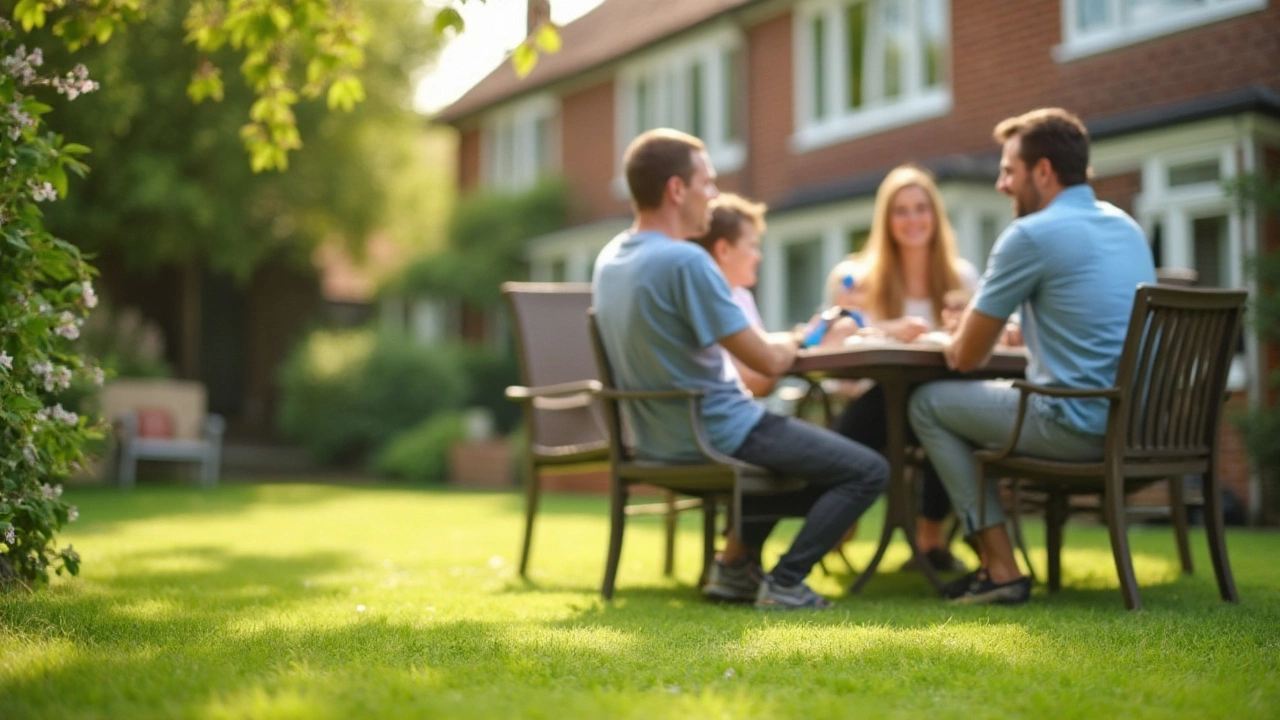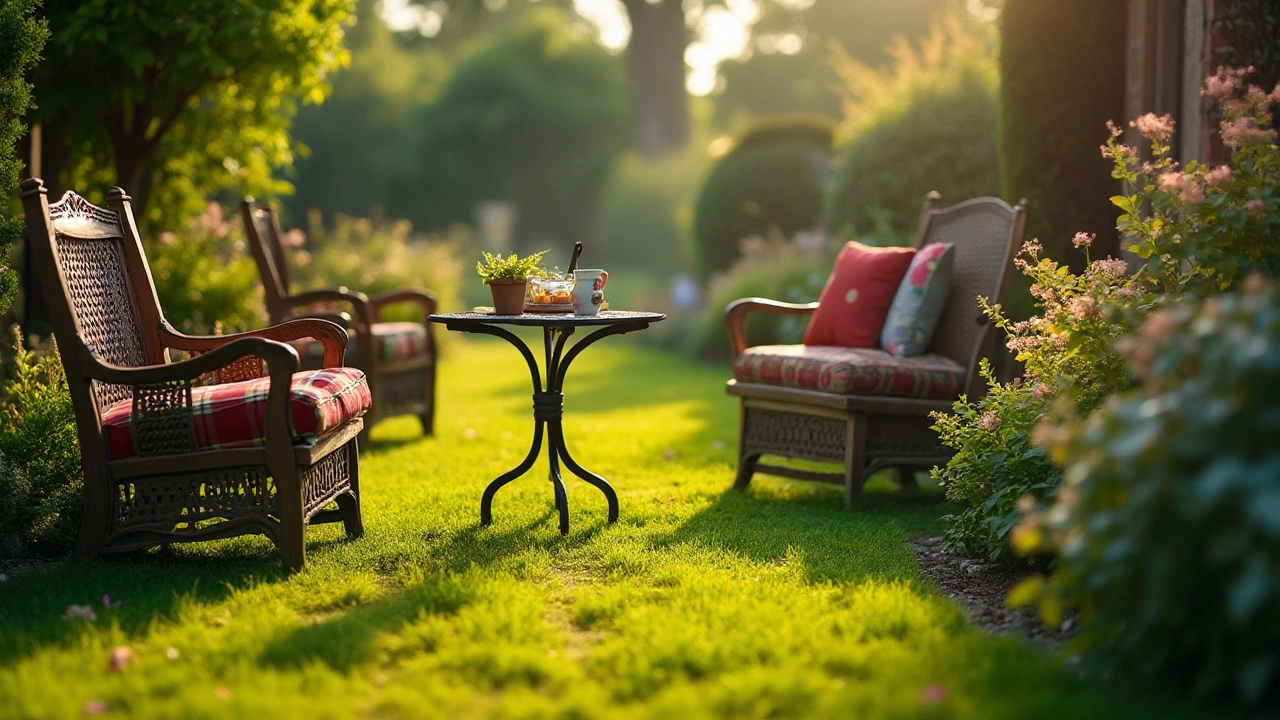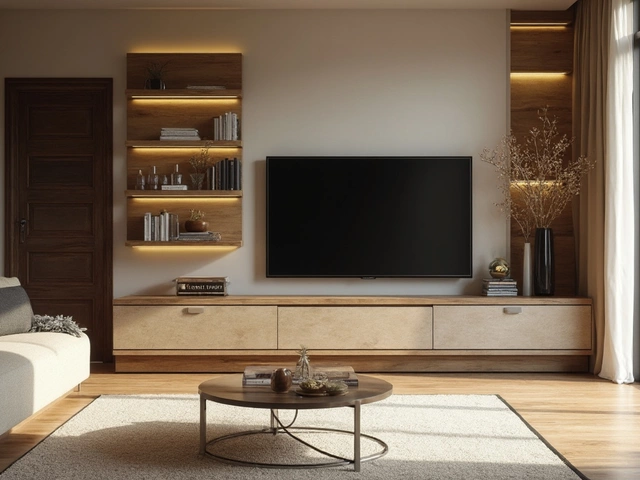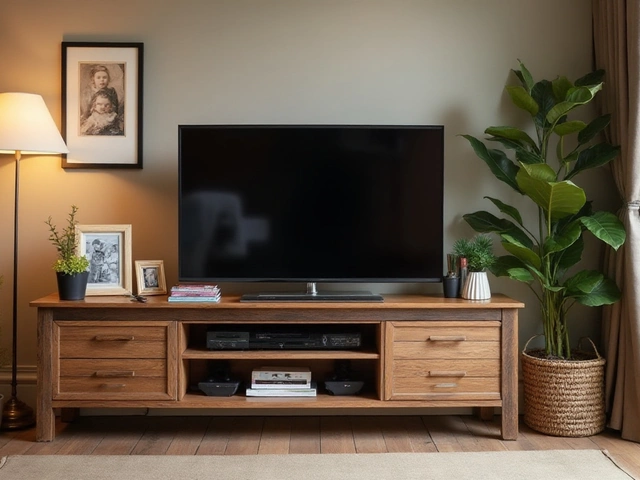As you arrange your garden furniture for those long, delightful afternoons outside, it’s tempting to set it right atop the lush green grass. But is this really the best move for your garden, and how does it impact both your outdoor furniture and the lawn itself?
Setting up furniture on grass is a common choice for many looking for a cozy and natural aesthetic. However, it poses some potential issues, particularly concerning the health of the grass and longevity of the furniture. Grass that is constantly covered by furniture can become discolored or damaged, given that it is deprived of sunlight and air circulation.
The materials that make up your garden furniture also play a crucial role. While wooden pieces give a classic look, they can absorb moisture from the damp grass, leading to potential issues if left unchecked. Metal and plastic furniture have their own pros and cons when used directly on the grass.
A strategic approach can help you strike a balance, ensuring your garden thrives while your furniture remains in good condition. Understanding how weather and seasonal changes affect both aspects will guide you in creating a more durable and enjoyable outdoor space.
- Impact of Furniture on Grass Health
- Material Considerations
- Weather and Season Effects
- How to Protect Your Lawn
- Furniture Maintenance Tips
- Best Practices for Year-Round Outdoor Setup
Impact of Furniture on Grass Health
The relationship between garden furniture and grass is intricate, one that promises more than simplicity at first glance. When furniture is left on your lawn for prolonged periods, the grass beneath can suffer, leading to unsightly brown patches and weakened turf. The primary reason for this is the blockage of essential sunlight. Grass thrives on sunlight, acting as its energy source through photosynthesis. Without enough light, it cannot produce the necessary nutrients, leading to thinning and discoloration.
Additionally, the weight of the outdoor furniture compresses the grass. This compression, especially in conjunction with foot traffic, compacts the soil beneath. Compacted soil becomes a hostile environment for grass roots as it reduces the soil's pore spaces, meaning there is less room for air and water to penetrate. Over time, this compaction can kill off sections of your lawn, creating an uneven and patchy look.
Moisture is another factor to consider. When moisture becomes trapped under garden furniture, it creates a damp, shady environment conducive to disease. Fungi and mildew are particularly troublesome for grass, taking hold in these ideal conditions. As noted by Dr. Emily Portman, a turfgrass specialist, "Keeping garden furniture on grass invites more than just an aesthetic problem; it can lead to systemic lawn health issues."
Even during milder seasons, grass can suffer. In spring and fall, when growth is vital, blocking sunlight impedes new shoots from developing. Similarly, during summer's dry spells, compacted soil exacerbates drought stress, as there is a diminished capacity to retain moisture. Because of these cumulative factors, unrelenting furniture placement can leave lasting scars on your lawn.
Yet, not all is dire. Understanding these affects assists in making more informed decisions about grass maintenance and garden care. By periodically relocating furniture, the grass has a chance to recover. Moreover, adopting a targeted lawn maintenance regimen that includes aeration and overseeding can help keep your lawn robust and resilient, able to bounce back even if furniture leaves its mark.
Material Considerations
When pondering whether to place your garden furniture directly on the grass, the type of materials your furniture is made from is crucial. Different materials react uniquely to outdoor elements and influence both the furniture's lifespan and the health of your lawn. Wooden furniture, for example, provides a rustic charm but can suffer from moisture absorption. This leads to potential issues like warping and decay, especially in damp environments. It's important to ensure wooden pieces are treated and sealed regularly to protect against these elements.
Metal furniture often boasts strength and durability, making it a popular choice for outdoor settings. However, it can be prone to rust when exposed to moisture, particularly when placed on grass where morning dew and accumulated rainwater become frequent companions. Using rust-resistant coatings or choosing metals like aluminum or stainless steel which naturally resist corrosion is advisable. Such preventive measures preserve your investment and keep your outdoor furniture looking new longer.
Plastic and wicker furniture offers lightweight and weather-resistant alternatives. These materials generally fare well in grassy settings, though they are not without their own vulnerabilities. Plastic can discolor over time due to UV exposure, while synthetic wicker, though more durable than natural wicker, can still wear and unravel if not meticulously maintained. An occasional wipe-down and relocation can often help these pieces maintain their appearance and functionality.
"Choosing the right furniture for your garden involves understanding not just its aesthetic appeal, but also how it interacts with and supports the environment," suggests garden design expert Fiona Ross.
Consider upholstery as well, usually covered in fabrics designed to withstand the outdoors. While these are often weather-resistant, leaving cushions on grass can lead to dampness and mildew, potentially affecting their longevity and comfort. Storing cushions when not in use or choosing fabrics treated for water resistance can mitigate this risk significantly.
Reflecting on these garden care tips can play an instrumental role in preserving both your furniture and your lawn. Maintenance routines, material treatments, and strategic positioning elevate the life and beauty of your outdoor setup. Through keen understanding of material properties and effects on grass, you'll enjoy a fruitful and aesthetically pleasing outdoor living space.

Weather and Season Effects
It’s remarkable how the shifting seasons can impact both your garden furniture and the lawn it rests upon. With each season comes its own set of challenges and opportunities when it comes to outdoor arrangements. During spring, for instance, grass is in its prime, fresh and eager to grow. However, frequent spring rains can lead to soggy grounds, which, in conjunction with the weight of outdoor furniture, can create indentations or even leave patches of mud beneath. This can affect the appearance of your lawn and also expose wooden furniture legs to prolonged moisture, inevitable leading to potential rotting or warping.
Summer brings dry spells in many regions, which might make the ground firmer, reducing the chances of your furniture sinking into the soil. Yet, the intense sun can cause the vivid green of your lawn to fade if furniture is left in one spot for lengthy periods, shading the grass beneath while also heating the materials made of metal or plastic to uncomfortable levels. The heat can also cause some materials to warp or degrade faster than they might otherwise. Strategically relocating your furnishings, if feasible, helps your yard remain vibrant and your furniture protected from the harshest rays.
Autumn introduces a different set of conditions. The falling leaves create a picturesque environment, but when left to gather under your garden furniture, they can trap moisture, leading to mold or mildew, which isn’t just unsightly, but can be damaging over time. As the days grow cooler and wetter, lawns begin to absorb more water, making it vital to periodically lift and reposition furniture to prevent any long-term damage to both the grass and the furniture materials.
Winter, however, poses the toughest test. Harsh weather conditions like snow, frost, and rain can drastically affect the durability of your garden furniture if left outside without any protection. The frost can cause certain materials to become brittle, particularly plastics, while metals might suffer from rusting. Grass, under the weight of snow-laden furniture, becomes more susceptible to breakage and disease. It is during this time that ensuring your furniture is cleaned, covered, or even temporarily relocated to a drier spot, becomes essential to extend its life.
According to the Royal Horticultural Society, it’s not just about protecting the grass. They suggest regularly moving your outdoor furniture around to avoid any damage to both furniture and plants, maintaining a beautiful and functional garden year-round.
"A well-maintained garden doesn’t just happen by chance. Clever and consistent care around the turf and your furniture arrangement is key to every season's particularities."Such insights encourage thoughtful planning based on seasonal changes, promoting the lasting health of both your outdoor settings and spaces.
How to Protect Your Lawn
The lush, green grass in your garden must be more than just a pleasing backdrop to your outdoor ensemble - it's an essential part of the ecosystem and aesthetic that you maintain. To protect your lawn when placing garden furniture directly on it, consider the impact of prolonged pressure and lack of sunlight. Heavy furniture can compress the soil, leading to poor drainage and root damage. Gradually, this can cause unsightly brown patches. To counteract this, move your outdoor furniture around frequently. Rotating chairs and tables, even slightly, allows sunlight to reach recently covered areas, giving the grass a chance to recover. It’s a simple, yet effective method to keep your garden vibrant and your lawn healthy.
Another crucial aspect is the type of underlying support you might use to minimize contact with the grass. Using pads or small, flat stones under the legs of your garden furniture can significantly reduce the risk of soil compaction. This makes sure weight is distributed more evenly, thus alleviating pressure on specific points. When installing such supports, ensure they're aligned properly to maintain the stability of the furniture while offering the necessary protection to your grass. With the right tools and some time, integrating this into your garden setup can make a noticeable difference over time.
Considering the materials from which your furniture is made is also important. This affects not just the grass below but also the maintenance needed for your furniture. For instance, many gardeners swear by the appealing charm of wooden furniture but are unaware of the risk of wood rot due to moisture absorption from wet grass. While metal furniture can rust if left unchecked, especially where it contacts damp grass, plastics may warp under pressure. So, it’s wise to treat these materials with the appropriate weather-proofing solutions. Applying a sealant for wood or rust inhibitor for metals can help in protecting both the furniture and lawn in your outdoor setup.
Implementing a protective layer can also be beneficial. An easy approach is to lay out outdoor rugs or mats designed for garden use. These can shield the grass from the harsh impact of repeated foot traffic and furniture placement. Ensure these mats are breathable to prevent suffocating the grass. High-quality mats will allow water and air to pass through, promoting healthy growth while maintaining the structural integrity of both the lawn and your furniture.
If shifting furniture regularly seems impractical for you, creating a dedicated patio area using gravel or paving stones can help. This doesn’t only offer a stable and durable reading platform but effortlessly integrates into the natural landscape without disrupting the vivid green expanse of your lawn. Transitioning from grass to paving allows you to accommodate a wider range of furniture types while enjoying the benefits of easier maintenance and cleanup. As landscape architect Mary Hill famously notes,
"A well-planned garden acknowledges space for both nature's solace and human interaction."

Furniture Maintenance Tips
Ensuring the longevity of your garden furniture requires a blend of regular care, attention to detail, and an understanding of the materials involved. When your beloved outdoor pieces are stationed on grass, they are subject to a unique set of challenges. This environment can expose the furniture to moisture, dirt, and temperature fluctuations, all of which can accelerate wear and tear. One of the primary concerns is moisture retention, which is more problematic for wood and certain metals. Moisture trapped beneath the furniture can lead not only to rust on metal surfaces but also to mildew and rot, especially in porous materials like wood. Addressing these potential issues head-on with preventive measures can greatly extend the life of your furniture.
Begin your maintenance routine by cleaning your outdoor furniture regularly. A mild detergent mixed with warm water works wonders for most materials. Consider an annual deep clean before the beginning of the season; this will remove any mold or mildew that might have accumulated during the colder months. For wood, specially formulated oil or a quality sealant can protect the material from water damage and sun exposure. Meanwhile, metal furniture may benefit from a protective layer of wax or paint that safeguards against rust. An aftercare tip - always check the hardware for any loose screws or bolts; tight furniture tends to last longer as it resists wobbling and bending with use.
As you keep your furniture in top shape, storing seasonal items is a necessity for many. If you live in an area that experiences harsh winters, then bringing in cushions and more delicate items, or investing in covers for your bulkier outdoor furniture, prevents unnecessary damage. Gary Yarham, a renowned horticulturist, once said,
"Preserve and protect by adjusting with the seasons, securing your garden for an enduring grace."Such seasonal considerations will not only preserve the look and function of your pieces but also reduce maintenance work later. This simple step can significantly boost the durability of your garden setup, ensuring it remains inviting and functional year-round.
To monitor the effect of direct contact with the grass, consider rearranging your garden furniture from time to time. It prevents one spot from becoming overly compacted, which can damage both the lawn beneath and the furniture above. This practice also helps in spotting problems early – whether it’s a piece starting to warp or a lawn area struggling to bounce back. When possible, use furniture glides or pads beneath each leg to create a small barrier between the grass and your furniture, reducing potential moisture buildup.
Finally, keep an eye on the weather and take quick action when needed. Storms and heavy rainfall can wreak havoc on exposed outdoor furniture. At times, simply tilting chairs to allow rainwater runoff can make a world of difference. If you’re expecting severe weather, covering or moving fragile pieces indoors can save you from deterioration costs and extend their lifespan significantly. By following these thoughtful maintenance practices, you'll ensure your garden remains a serene oasis equipped for enjoyment throughout many seasons.
Best Practices for Year-Round Outdoor Setup
Creating a welcoming outdoor environment where you can relax all year long requires a bit of planning and care. Whether you're an experienced gardener or someone just starting out, knowing how to manage your garden furniture and lawn across the seasons is essential for maintaining both aesthetics and functionality. A good starting point is choosing the right spot. Ideally, your outdoor furniture should be placed where it can enjoy both sunshine and shade at different times of the day, allowing for a comfortable experience regardless of the weather.
Thinking about the material of your furniture is just as vital. Certain materials, like teak and cedar, are famous for their resistance to the elements, making them excellent choices for year-round outdoor setups. For those with metal furniture, beware of rust and take steps to keep it at bay. Applying a protective sealant can prolong the life of these pieces significantly. Plastic options, though less luxurious, offer excellent durability and require minimal upkeep, which can be ideal for low-maintenance scenarios.
Adapting to Seasonal Changes
The seasonal shifts bring challenges and opportunities for your garden setup. In spring, when nature begins to blossom, it might be time to rearrange your furniture to accommodate the new blooms and budding activity. Make sure to check for any signs of mold or dirt that might have accumulated over the winter. Summer, with its harsh sun, can take a toll on both the lawn and furniture, so it's critical to utilize umbrellas or canopy structures to offer respite from the heat.
Come autumn, fallen leaves should be cleared regularly to prevent them from trapping moisture against your lawn or furniture, potentially causing damage. The colder months present their own trials, as snow, ice, and rain can wreak havoc on surfaces. Consider investing in covers that provide full protection against moisture and frost. According to the experts at the National Association of Landscape Professionals, 'A balance between aesthetics and functionality will always result in the most rewarding outdoor spaces.'
Regular Maintenance and Lawn Care
Effective maintenance is about consistency. Cleaning your outdoor setup throughout the year keeps it in prime condition. Simple acts, like wiping down surfaces or oiling wooden areas occasionally, make a big difference over time. The same applies to your grass; aerating it can improve water and nutrient absorption, ensuring a vibrant lawn year-round. Mowing practices should adjust to the seasons, with higher cuts during summer to prevent grass from drying out.
| Season | Recommended Action |
|---|---|
| Spring | Reposition furniture, check for mold |
| Summer | Use shade accessories, regular maintenance |
| Autumn | Clear leaves, prepare for winter |
| Winter | Cover furniture, protect against ice |
The reward for your efforts is not just a beautiful garden but also furniture that lasts for years. Whether hosting gatherings or seeking solitude, the right setup can transform your lawn into a personal paradise no matter the month.





